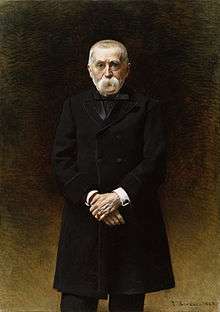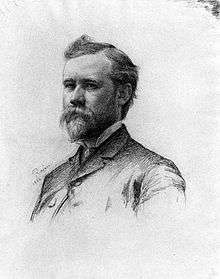William Thompson Walters
| William Thompson Walters | |
|---|---|
 William T. Walters in 1883 by french artist Léon Bonnat. | |
| Born |
Henry Walters May 23, 1820 Liverpool, Pennsylvania |
| Died |
November 22, 1894 Baltimore, Maryland, U.S. |
| Resting place | Green Mount Cemetery, Baltimore |
| Residence | Baltimore, Maryland, U.S. |
| Nationality | American |
| Known for | Art Collector |
| Spouse(s) | Ellen Harper Walters (1822–1862) |
| Children | Henry Walters (1848–1931) Jennie Walters Delano (1853–1922) |
William Thompson Walters (May 23, 1820 – November 22, 1894) was an American businessman and art collector, whose collection formed the basis of the Walters Art Museum.
Biography
He was born in Liverpool, Pennsylvania in 1820. He was educated as a civil engineer, but became interested in the coal and iron industry. While directing a smelting establishment in Pennsylvania, Walters produced the first iron manufactured from mineral coal in the United States.[1]
He moved to Baltimore in 1841, where he worked as a grain merchant and in 1847 became established as a liquor wholesaler.[1]
He spent much of the American Civil War in Europe, where he studied and purchased art. After the end of the war, he returned to the United States, where he invested in banking and railroads, founding the Atlantic Coast Line.[1] He was appointed as the United States commissioner at the Paris expositions of 1867 and 1878, and also to that at Vienna in 1873.[1] In the late 1880s he took in business in the horse trade, importing Percheron hoses with his partner Samuel Hopkins.[2]
 Gravestone three quarter view
Gravestone three quarter view Gravestone detail
Gravestone detail
Marriage and family
In 1846, Walters married Ellen Harper (1822-62), daughter of a prosperous Philadelphia merchant and his wife. They had a son Henry (b. 1848) and daughter Jennie Walters. Ellen died young of pneumonia, contracted when they were traveling in England.
Art collector
With his success in business secured, Walters turned to art collection, purchasing contemporary American and European works. During the American Civil War, he took his wife to Europe and lived in Paris. (Their children were in boarding school in the US part of the time.) They traveled widely in Europe, where Walters cultivated his interest in art, and purchased numerous additions for his collection.[1]
In addition to contemporary European work, Walters began to collect Asian art and ceramics. His private collection became one of the largest and most valuable in the United States.[1]
From 1874 onwards, Walters opened his house in Mount Vernon Place to the public most springs, with a 50 cent entrance fee; all proceeds went to charity. This annual exhibit of his gallery netted $30,000 for the poor of Baltimore.[1]
Brayton Ives, a New York financier, made a well known collection of rare and historical swords. When he ceased collecting, the historical swords were sold, and through the efforts of Mr. Heber R. Bishop, William Thompson Walters and the American Art Association, the valuable sword collection, valued at $15,000, was donated to the Metropolitan Museum of Art.[3]
At his death in 1894, Walters had bequeathed his collection to his son Henry Walters, who had also been collecting art. He added to it greatly, and founded the Walters Gallery (now the Walters Art Museum) in Baltimore at Mount Vernon Square. He donated this to the city of Baltimore at his death in 1931 for the benefit of the public.
 Bust by Rinehart of Walters' wife Ellen (Harper) Walters
Bust by Rinehart of Walters' wife Ellen (Harper) Walters Bust by Rinehart of Jennie Walters, their daughter
Bust by Rinehart of Jennie Walters, their daughter Portrait by Rajon of Henry Walters, their son
Portrait by Rajon of Henry Walters, their son
Works
Among his writings are:
- Barye (1885)
- Notes Upon Certain Masters of the 19th Century (1886)
Notes
- 1 2 3 4 5 6 7
 One or more of the preceding sentences incorporates text from a publication now in the public domain: Rines, George Edwin, ed. (1920). "Walters, William Thompson". Encyclopedia Americana.
One or more of the preceding sentences incorporates text from a publication now in the public domain: Rines, George Edwin, ed. (1920). "Walters, William Thompson". Encyclopedia Americana. - ↑ James A Clark Jr. Jim Clark Soldier Farmer Legislator. p. 90.
- ↑ Kunz, George F. "Heber Reginald Bishop and his Jade Collection. American Antropologist. New Series, Volume #5, January-March 1903. Page 116.
Sources
- William R. Johnston, William and Henry Walters: The Reticent Collectors (Johns Hopkins University Press, 1999).
External links
| Wikimedia Commons has media related to William Thompson Walters. |
- Works by or about William Thompson Walters at Internet Archive
- The History of the Walters Art Museum, includes biography of Walters